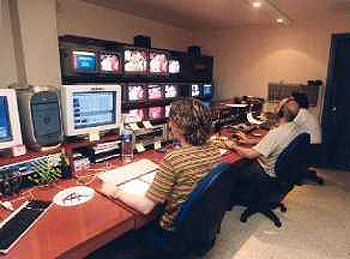
|
Summary
1.
The changes in the communication systems and local TV: a Copernican drive
1.1.
The fragmentation of audiences
1.2.
The role of public broadcasting versus the private broadcasting
2.
Language promotion and TV: what the laws regulate
2.1. The support
towards language promotion
2.2. Specification of
broadcasting quotas in Catalan language
2.3. Sanctionning regime
3. Legal framework of local TV
4. The
role of mass media in the process of language promotion
4.1. The process of
language promotion in the media: a matter of quota
4.2. The process of
language promotion in the media: the role of the standard language
5. Conclusions
6. Bibliography
1.The changes in the
communication systems and local TV: a Copernican drive
It would be mistaken to speak of local television and not stress the substantial
transformation that the communication systems is currently undergoing. And note that I am
referring to systems and not to media because our present and future are marked by the
"process of convergence and interrelation of telecommunications, mass media and
information technologies" (1).
This
phenomenon started in 1987 with the publication of the Green Book on the Development of
the Common Market of Telecommunication Services and Equipments, which opened the first
crack in the existing monopoly of the telecommunications services in Europe and laid the
foundations for the liberalization of the telecommunications sector in Spain. Indeed, the
first Spanish legal framework relating to this sector also dates from 1987, (2) concluding with the approval, 11
years later, of the Law 11/1998, 24 of April, on telecommunications. This parliamentary
act allowed for the complete separation of telecommunications services that until then
where offered together with the telephone service and its network (3).

The future of local TV channels
depends on digital technology
However, in Spain, the State and the autonomous regions have different
competences with respect to the legislative development of the television sector and its
related technologies. It is for that reason that while article 149 of the Spanish
Constitutional Law states that the central government enjoys exclusive competences
regarding telecommunications, article 16 of the Statute of Autonomy of Catalonia assigns
the Catalan autonomous government exclusive competence with respect to the legislative
development and the implementation of the radio and television broadcasting regime. In
broader terms, it assigns such competence with respect to all television media within the
framework of the basic norms of the State (4). This regulating competence has
been in operation since 1996, creating a legislative policy for the audiovisual sector
which has itself been forced to adapt to the same changes undergone by the
telecommunications and related technologies domain (5).
Needless to say the legislative policy (as mentioned in Report 1/1999 of the
Audiovisual Council of Catalunya), (6) was initially based on the use of
a limited resource (that is, the radio frequencies), and on the public interest inherent
to broadcasting as a highly relevant tool for the transformation of the public opinion.
However, liberalization of the sector, jointly with increasing use of the new digital
techniques in the dissemination of information, brought about a change, still in progress,
from a situation characterized by a restricted number of frequencies and, therefore,
channels available, to one where frequencies are multiplying. This expansion makes
possible the appearance of hundreds of digital broadcasting channels on different networks
|

